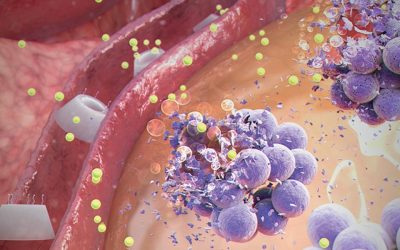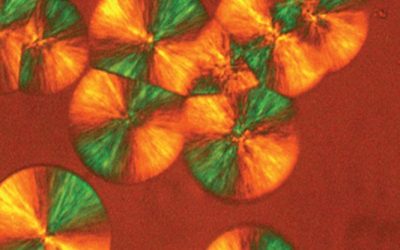Wednesday 29/1
US navy researchers create a new kind of tunnel device structure with both the tunnel barrier and transport channel made of graphene (R&D Magazine).
Imitating nature, Professor Francois Barthelat and colleagues have glass more flexible, and less brittle (Eurekalert).
The EPFL publish research on lead iodide perovskite solar cells, giving a better understanding of how these devices transfer electrons along their surface (EPFL News).
An Imperial College London team unveil their new catalytic converter prototype, which uses 80% less rare metal than current designs (R&D Magazine).
USAID announce that CONRAD, a reproductive health organisation, have been awarded a science and technology pioneers prize for their anti-HIV tenofovir gel (Eurekalert).
A new model from University of Houston researchers might lead to better semiconducting polymer/fullerene blend solar cells (University of Houston)
A Rutgers-Camden researcher has been awarded $50,000 by the US DoD to investigate DNA nanoarchitectures, in the hope of developing better nanostructures (Eurekalert).
Interesting papers
Quantum metrology with parametric amplifier-based photon correlation interferometers (Nature Communications)
A novel ozone gas sensor based on one dimensional (1D) α-Ag2WO4 nanostructures (Nanoscale)
Emerging device applications for semiconducting two-dimensional transition metal dichalcogenides (ACS Nano)
Scalable synthesis of silicon nanosheets from sand as an anode for Li-ion batteries (Nanoscale)
Thursday 30/1
University of Delaware researchers publish work on a catalyst that can convert CO2 to CO with 92% efficiency (Eurekalert; paper in Nature Communications).
A composite paper electrode – made from molybdenum disulfide and graphene nanosheets – is shown to act as both an active sodium atom storage material and a flexible current collector (Azonano).
Hot electrons generated by surface plasmonics in metal nanoparticles are “clocked” by Rice University researchers (Eurekalert).
The Pacific Northwest National Laboratory announce that they will start construction on a new energy research facility in April (R&D Magazine).
An international collaboration shrink the components of a quantum computer to a size where they can – and are! – integrated onto a silicon microchip (Eurekalert).
A call is made for new environmental assessment methods to be used to determine antibacterial silver’s effect on people and the environment (phys.org).
Early studies show that polymer microspheres could play a major part in future implant surgeries (Eurekalert).
Helmholtz Dresden researchers combine DNA origami with pattern formation to produce self-aligning DNA nanowires for electronics (ScienceDaily).
A team from NIST in the US announce a breakthrough in our understanding of piezoelectrics (Eurekalert).
Friday 31/1
New York University hold a workshop to mark the opening of their new Institute for Engineered Interfaces, featuring Harvard professor (and materials science legend) George Whitesides (Eurekalert).
A polarized light screen made from quantum dots and microstructures is fabricated by a team at Linköping University (Linköping University).
Lund University researchers announce a new X-ray method intended to allow the development of better catalysts (Eurekalert).
Simon Fraser University, British Columbia, announce the opening of their new Centre for Soft Materials (Azonano)
Professor Megan Robertson receives a $500,000 grant from the NSF to research plant-based plastics and rubbers (Eurekalert)
Bioengineers at Penn State publish their work on tissue engineering for the treatment of arterial and muscle damage (Azom)
Interesting Papers
When electrons leave holes in organic solar cells (Science)
Monday 3/2
The first single-molecule LED is created by researchers in France (AlphaGalileo).
Federico Rosei receives a Steacie Fellowship from the Natural Sciences and Engineering Research Council of Canada for his work in multifunctional materials (Eurekalert).
Belgian scientists use the language of particle physics to describe the behaviour of excitions in multi-layer graphene (AlphaGalileo).
Calculations by an international research team suggest that perfect atomic-thickness sheets of diamond could be created without the need for high pressure (Rice University News)
Germany scientists release an update on their attempts to build a single-ion heat engine (AlphaGalileo).
A new bone-like material, less dense than water but as strong as steel, is created by researchers at the Karlsruhe Insitute of Technology (phys.org).
An EPFL team, working on spintronics technology, announce that they have cracked a key problem of topographical insulators (EPFL News).
Better error correction for the storage of quantum states in diamond is developed at TU Delft (phys.org).
Tuesday 4/2
Scientists working on the Materials Project database give an overview of the discoveries that have been aided by the system to date (MIT news).
New insights on the thermodynamic behaviour of nanosystems are published by researchers from Spain and Mexico (AlphaGalileo).
A Washington State University team make a big leap in ensuring that future lithium-ion batteries are safer than their contemporary counterparts (Eurekalert).
















